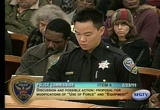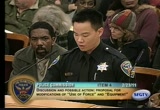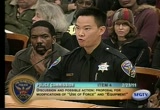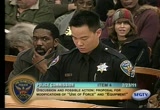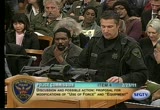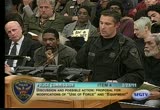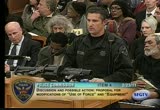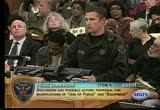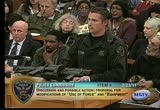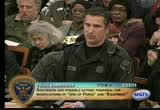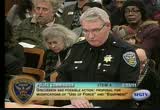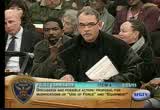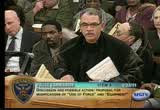tv [untitled] February 24, 2011 8:00pm-8:30pm PST
8:00 pm
to try to put themselves in my shoes during this scenario. on february 20, he three days ago, i responded to a domestic assault and battery car recall upon a child. the mother called the police taking her husband had been using drugs and had just struck their kid. the mother was outside with her two kids. i entered the apartment and found the suspect sitting on the bedroom floor. i ask him to stand up and he complied. i told him to turn around and i was going to put handcuffs on him. i attempted to place a twist lock grip so i could handcuff the suspect. the suspect yelled out, "i am not going. you cannot take me. shoot me. kill me.
8:01 pm
-- kill me." i called for a distress call over the radio. i only had one chance to put out the radio call clear and concise. i looked down and spoken to my microphone. as i looked down, the suspect grabbed my head and placed my head into a guillotine-type of hold. another sergeant was on scene and attempted to subdue the other free arm of the suspect to no avail. when the suspect put his arms around my neck, he was choking me. i could feel my carotid pulsing. i punched the suspect numerous times to no avail. he did not release his grip. at the time, the only thing that came to mind was to use my firearm. my oc was not in play.
8:02 pm
i could i use a baton because of the distance. my head was buried in his chest. at the same time, the suspect was able to grab my microphone cord and ripped it from my radio, so i did not have a mic. i was not able to be in contact with communications for over four minutes. another officer arrived at the location. he was able to free myself from the suspect's chokehold. that officer, myself, and the sergeant continued to struggle with the suspect until other officers arrived on scene. it took a total of six officers
8:03 pm
to subdue the suspect. we had to subdue the suspect. he was continuing to kick his legs, kicking at officers. the suspect continued to grab equipment from the gun belt and try to grab radios with negative result. we were able to subdue the suspect with eight officers. i am your standing in front of you tonight hoping commissioners will take a serious look at providing officers with an additional tools, such as a taser, to use in a situation like this. because the third officer arrived on scene just in time, i did not have to use lethal force to stop the threat of the suspect who was choking me.
8:04 pm
thank you for your time. president mazzucco: thank you come officer. chief, we will get him a microphone tomorrow. >> our last speaker will be the legal use of force expert from our tactical unit. he is experienced in devices and will discuss the sl6 used by the crisis intervention team in the memphis pd. >> good evening.
8:05 pm
i'm a member of the tactical units in the san francisco police department. i have been with the police department for 17 years. i am currently an instructor in numerous subject matters, including firearms, diversionary devices, crowd control, use of force, and numerous subject matters that i have been trained in over the years. i was asked to talk about this multi-launcher, which the tactical unit currently deploys with, as it with a possibly been used in the scenario described earlier tonight. i have been through many courses in less-lethal use of force instruction, and there is no magic tool for every circumstance. there is no miracle pill when it comes to less-lethal force option. in the scenario we saw earlier
8:06 pm
tonight, you had two officers who were responding as regular patrol officers with the tools they had on their person. they did not have the luxury of having additional tools, which you can see are extremely bulky and cumbersome, and not readily deployable. to be able to be carried in vehicles and trucks, as you can see, it has to be taken out the carrying case. you will not respond to a domestic disturbance with such a weapon. in that scenario, one of the officers did have a taser, which is a nice option to have. you can carry it on your person and it is readily available in extremely dynamic situations. this is an option that we have. it is not necessarily the miracle pill for less lethal ammunition. in that scenario, when officers respond to calls in san francisco, they end up inside of buildings and structures. when you are inside buildings
8:07 pm
and structures, you are in close proximity to the people which you are dealing with. these munitions come out of approximately 250 feet per second. they deployed a rubber baton. this is what it looks like. this is what the baton looks like when it exits the weapon, striking the subject at approximately to under 50 feet per second, depending on the distance. the farther away, the less of an impact they have. in that scenario, they would have been within 10 feet of the subject, which is extremely close proximity. if they hit somebody in a non- target area, head, neck, throat, groin, kidneys, it could cause blunt trauma and possibly be fatal. the taser is an electric current that is considered a lesser level of force.
8:08 pm
in all reality, this particular delivery system is more effective in a crowd control situation, which is when it is more often than not deployed. basically, i was brought here to answer any questions if you had them, or if there are -- there is any of the information you need regarding the less lethal options we have. these are not deployed by regular patrol officers. they're deployed to the special weapons and tactics unit to deal with high-risk search warrants and other events. the training we get exceeds the rest of the department at large, given the time it takes to train as in these types of munitions and to be proficient. there are any questions, i would be willing to answer them. >> you're saying that weapon is probably not a good weapon for
8:09 pm
close situations. we had a domestic violence call this evening. >> it could be used, but it is not a preferred weapon for that particular type of circumstance. >> why is it not preferred? >> the capability of causing blunt trauma is extremely great. this type of a weapon, we usually deployed it more open -- in more open spaces as opposed to close quarters. commissioner hammer: thank you for coming tonight. when we were in los angeles -- is this a different route? >> it is a different company. we contract with combined tactical systems. we did. we initially began the program with the launching system. we were using it. commissioner hammer: i don't want to ask many questions. some of our colleagues will go in depth. having worked in and around law-
8:10 pm
enforcement for 25 years, i had never heard about this. commissioner cahhan and i heard about it from the memphis police department. they used tasers and they were not effective. i was blown away by how far -- how hard and fast this weapon was. >> background comes out at 300 feet per second. this comes out at 250 feet per second. probably creates the same type of energy because the gramm weight of this is 60 grams. i know that is a little bit later. i could pass this around. you can see the type of particular round is a little bit heavier. that is why this technology has a faster, hotter charge in it. it is creating the same kinetic energy. it is just a little bit like to. commissioner hammer: i don't
8:11 pm
want to go into the details tonight. hopefully our colleagues can do that and come back with us. one of the things that intrigued me about this particular weapon and this what expert told us it is effective up to 100 feet. is that correct? >> 30 yards is the optimal distance. you can get it to about 35. when we train, we train up to about 20 yards with this one. we have a single shot version of it. we have an optic on it. we use it up to 25 yards. commissioner hammer: the tasers, you have to get within 20 feet or so. with this, you might be 20 yards away. >> that is the nice thing about it. in close proximity, it is easier to manipulate. commissioner hammer: depending on the situation, there are advantages to some. >> correct. commissioner hammer: thank you very much. >> if i heard you correctly, the
8:12 pm
officers don't carry this particular weapon. is that correct? >> the only officers carrying this particular weapon are members of the swat team. >> other officers do not have this available to them. >> they do not. >> in memphis they do. >> other questions? >> thank you for giving us this demonstration and showing us this weapon. we were curious about it ever since we heard from the memphis folks. the sl6 is their version of this weapon. >> there made by the same manufacturer. they contract out with other agencies. >> the reason they chose something like this was they found it to be more effective than tasers, which they found to be only 50% effective.
8:13 pm
has there been any comparison between the two come any studies done, comparing the safety and effectiveness? >> you're comparing apples to oranges. one is an electric current and one is an impact weapon. one is designed to disrupt the bodily functions. one is designed to create blunt trauma. >> thank you. if this passes, we will be talking with you quite a bit. thank you. commissioner dejesus: in the demonstration we saw, the person was advancing with a knife within 5 feet of the officer. are the officers trained to use a taser or baton in that situation? are they trained to use a lethal weapon? >> at this stage, we don't have tasers. current training, their options would have been -- a knife- wielding subject is a level of deadly force. we are not trained to go lesser
8:14 pm
level of force to a higher level of force. in that situation, they could have used a taser. if that did not work, their only option is lethal force. commissioner dejesus: do you know of instances where an officer -- and i've-wielding person is four feet from the officer and use the tasered? >> i cannot answer statistics like that. >> commissioner, i would like to read one component. the problem with this weapon is the officers are all not going to be able to carry that in a patrol car. that weapon would have had to be driven out to that location, even if we were going to conceivably use that in the senate -- in this scenario, which we wouldn't have. the minute the officer grabs that weapon and has to have another officer that guards him. his gun is of no use to him because his hands are full with this. he has to have a gardening
8:15 pm
officers standing by in case legal force has to be used. their dynamics that we can look at. once this officer grabs that weapon, he has to have somebody standing next to him. >> that is correct. that is our department policy. there has to be a lethal cover. >> it would apply to any scenario, a taser, any other type of weapon that is used. there would be a guardian. >> there should be. there should be communication between the officers responding. one would be illegal cover officer. you don't want to have to transition and think about that at that time. there should be a game plan between the officers responding. >> thank you. >> we have a question. >> that is the end of the presentation, right? >> yes. >> i'm sorry. when you wrap it up, i will ask.
8:16 pm
>> in conclusion, i believe the department and public would benefit from our officers having all available less than lethal tools of their disposal. you should know there are over 800 agencies in california who use the ced. every day, the men and women of our department come to work and put themselves in harm's way, as we signed on to do. as managers and policy makers, it is incumbent upon us to make sure our members are properly trained and equipped so they go home to their loved ones. i wish to acknowledge the work on the part of the department, those in the office of administrative services, training division, my staff, the role players tonight, the speakers, and commissioners mazzucco and hammer. that includes the department's presentation and request for approval to develop a pilot program to equip our members with ced.
8:17 pm
the panel is available for further inquiries. >> can i jump in real quick? anybody in this room that is part of the police department, please stand up. everybody in the room in plain clothes, stand up. every night, i go to bed. i take this phone i have and i stick it next to my nightstand. it stays on 24 hours a day, seven days a week. everybody in this room -- i am as passionate about them and keeping them safe. that is why i am coming back here again. all i ask from the commission is to take a thoughtful approach when the vote comes to you. i think you for the time and i think you to allow us to give this presentation. thank you. >> we have some representatives from various police officers' associations.
8:18 pm
let's bring them up as part of the presentation. you can share your opinions and stories. >> good evening. how are you? >> the evening. -- good evening. i am a lieutenant currently assigned to the homicide detail for san francisco pd and the president of the san francisco police officers pride alliance. we represent the 250 lgbt officers in the san francisco police department. this is an issue that i don't think i have ever seen my members so passionate about. they want another tool for the tool box. my organization over the last
8:19 pm
couple of years has lost a couple of our members who were involved in shootings. because of the stress of that encounter, they have left our police department. i don't want to see that happen to another officer. i want to see us have another tool to use other than our firearm when dealing with these difficult situations. we come upon violent suspects regularly. we need another force option other than the use of our firearm. i encourage this commission to give it careful thought and allow our officers to have the use of a ced device. thank you very much. >> good evening, president, commissioners. i am the current president for the san francisco latino police officers association. i want to echo what the lieutenant was saying.
8:20 pm
this is a device that i think would help benefit both the police officer and the public in maintaining and preventing the loss of life, which is our ultimate goal, that everybody go home safe, that every child in person we encounter leaves the same way they came to us. i wanted to stress one thing. i don't know if you have noticed. we come in every size, shape, and form in the police department. some of us have the advantage of being 6'2". there is a height and weight difference across the board. a tool like this helps equalize that level. when we come across the individual that is coming out of state prison, all the have had time to do is work on their physique, and their desire to continue on in the force. i am not a big guy. i cannot take on that
8:21 pm
individual. for me having this tool would benefit myself and that individual from both of us being hurt, one from being possibly injured lethally, and myself from being injured. i wanted to take this into consideration and anything that we can do within our organization or within the latino community to help in this search, we would be more than happy to help. thank you. >> good evening, commissioners, police chief. i'm a sergeant in the san francisco police department and president of the asian peace officers association for san francisco. this is a topic that needs to be explored. the public and our police officers -- and we have great police officers in this city with good management -- all we are asking to do is to look for
8:22 pm
an additional tool we can use to fill that gap between the firearm and baton. i think we deserve it and the people of san francisco, the citizens, we deserve it. please vote yes and let's look at this issue even further. thank you very much. >> a good evening, commissioners. i am kevin martin, the vice president of the san francisco police officers association. we represent over 2000 members of the san francisco police department. more importantly, we represent all over 750,000 residents of san francisco and close to 1 million people who come to san francisco every day. we are charged with their public safety and the safety of their loved ones. to ensure that once we go to work, we go home safely at night. the tool we are looking for,
8:23 pm
another option, the difference between legal force and another option that would incapacitate someone who is attacking, presenting a great physical danger and harm not only to an officer, but absolutely to members of the general public, your family, your loved ones, your next-door neighbor, people you know, people you work with. please, consider the absolute necessity of having another option. another tool in the toolbox. this extra tool is the difference between someone being killed and someone being incapacitated, taken into custody, in a very humane way. thank you very much. i appreciate your consideration. >> the commissioner has a
8:24 pm
question. commissioner dejesus: nice to see you again. i am looking -- you gave -- you have your guidelines that were sent out in 2005. since then, tasered international, the predominant manufacturer, has come out with a lot of different -- >> advisory's. i'm familiar with that. commissioner dejesus: that is not my concern. my understanding is when we last saw you here, there were saying, don't shoot in the face, the neck, the grind. those were the things i recall. i think now they're saying, don't shoot at individuals fleeing the scene. >> yes. we have concerns about that.
8:25 pm
one of our guidelines addresses that issue. commissioner dejesus: they also talk about vulnerabilities of certain people. they say, don't shoot -- >> at the elderly, and juvenile. commissioner dejesus: skinny people, sick people, which i don't know how you know they are sick people. they also are saying that they suggest that police departments do their own research. in terms of liability, that is one of the things. the second thing is, how would you advise -- how would an officer use this weapon effectively in the field of the cannot shoot when they're fleeing -- they can go in your eyes. they can go in your heart for your growing. they have but the warnings out there. what is the efficacy of this weapon? where are you supposed to shoot? >> you raise questions. having said that, i am familiar with the training bulletin that
8:26 pm
was sent out. we questioned the manufacturer about that and why they would send it out. at the end of the day, when a police officer -- police officers are dealing with real situations. when you listen to them talk, they don't want to use deadly force. they don't want to use deadly force in those circumstances. i know the manufacturer has said, don't shoot in the face, don't shoot in the groin, don't shoot in the critical mass area for various reasons. you don't want more injuries to occur. they say, shoot in the back. that makes it more difficult. in those circumstances -- at the end of the day, if you're the choice between giving them an alternative and giving them no alternative, i would rather give them the alternative, knowing they have to use it in a
8:27 pm
restricted way. really come in the circumstances were the police officers talked, what you heard in their voices was, we don't have to use deadly force in these circumstances. we don't want -- of baton will not be effective. we need something that will incapacitate someone for a few seconds so we can get in and control someone. you're right. everything you said is correct about what the manufacturer said. if you have to make a choice between giving them this alternative, which is very restricted, and no alternative, i would give them the option, then i would evaluate it, and also have accountability. the sheriff said in all this is years they used it, they only used it 14 times, says to me you can implement this, you can evaluate it, and you can have supervision and training. at the end of the day, what happened? this is not about taking life. this is about saving lives.
8:28 pm
it is about the police officers and the san francisco police department who are asking you for another option. you will still hold them accountable. they're saying, i don't want to use deadly force. this is not a circumstance i want to use my gun. give me an alternative. commissioner dejesus: that is the problem. after we met, tasered international is saying incapacitation involves risks that a person may get hurt or die. they say there is a risk of the application having a negative affect on a person's heart rate or rhythm. i guess my concern is perpetuating a fallacy, if they use a taser, the person will be safe. the taser is the only weapon that used as design can kill. commissioner dejesus: commissioner, could you --
8:29 pm
>> could you say that again? commissioner dejesus: using it as designed, it is a weapon, used in the way it can be used, it can cause death. >> it can. it is not designed to kill anyone. commissioner dejesus: i don't want our officers thinking they will tase the person and they will live. if used the way designed, it can cause death. it would be more of a shock to an officer using a taser thinking he will say the person and he kills the person because it electrocutes them, or it is a young person, a pregnant person, a skinny person, or someone who is sick. how do patrol officers know when people are sick? this weapon use the way it
94 Views
IN COLLECTIONS
SFGTV: San Francisco Government Television Television Archive
Television Archive  Television Archive News Search Service
Television Archive News Search Service 
Uploaded by TV Archive on

 Live Music Archive
Live Music Archive Librivox Free Audio
Librivox Free Audio Metropolitan Museum
Metropolitan Museum Cleveland Museum of Art
Cleveland Museum of Art Internet Arcade
Internet Arcade Console Living Room
Console Living Room Books to Borrow
Books to Borrow Open Library
Open Library TV News
TV News Understanding 9/11
Understanding 9/11